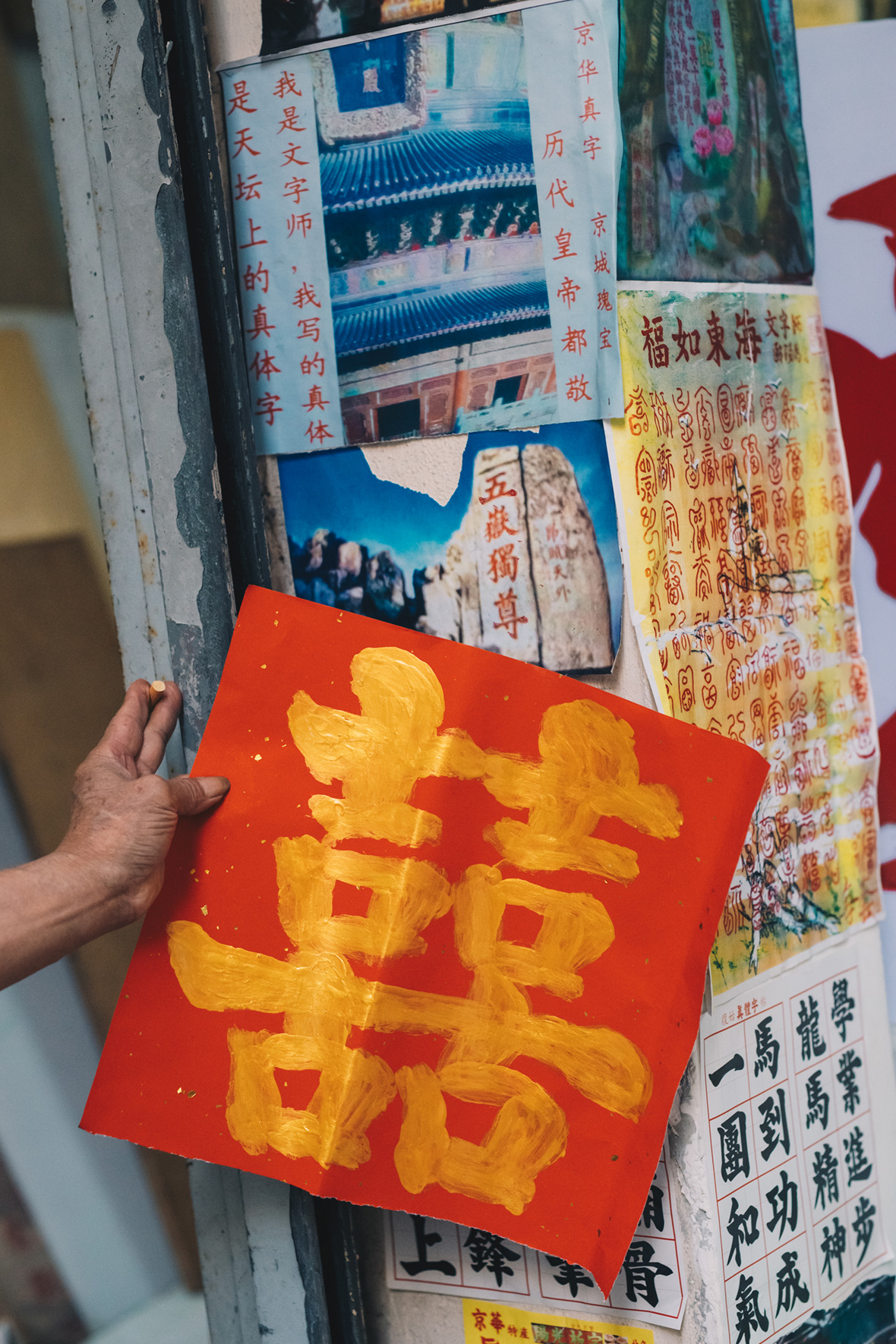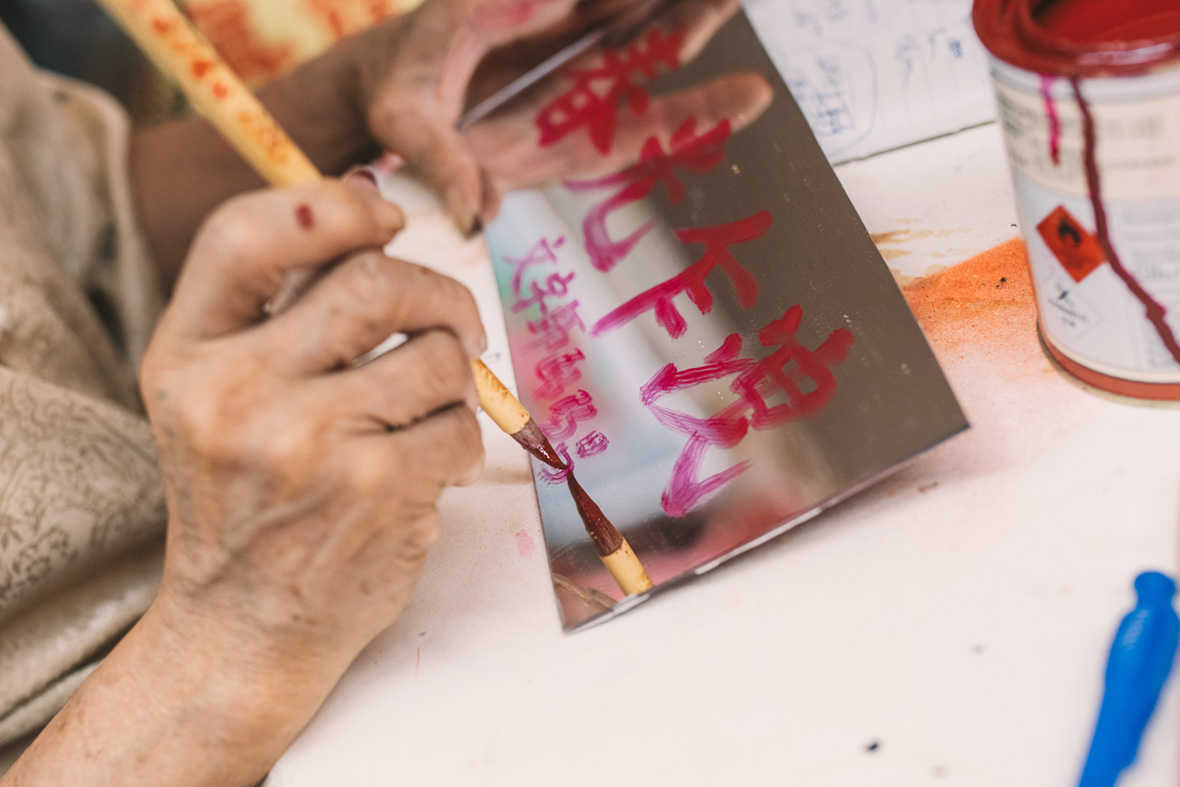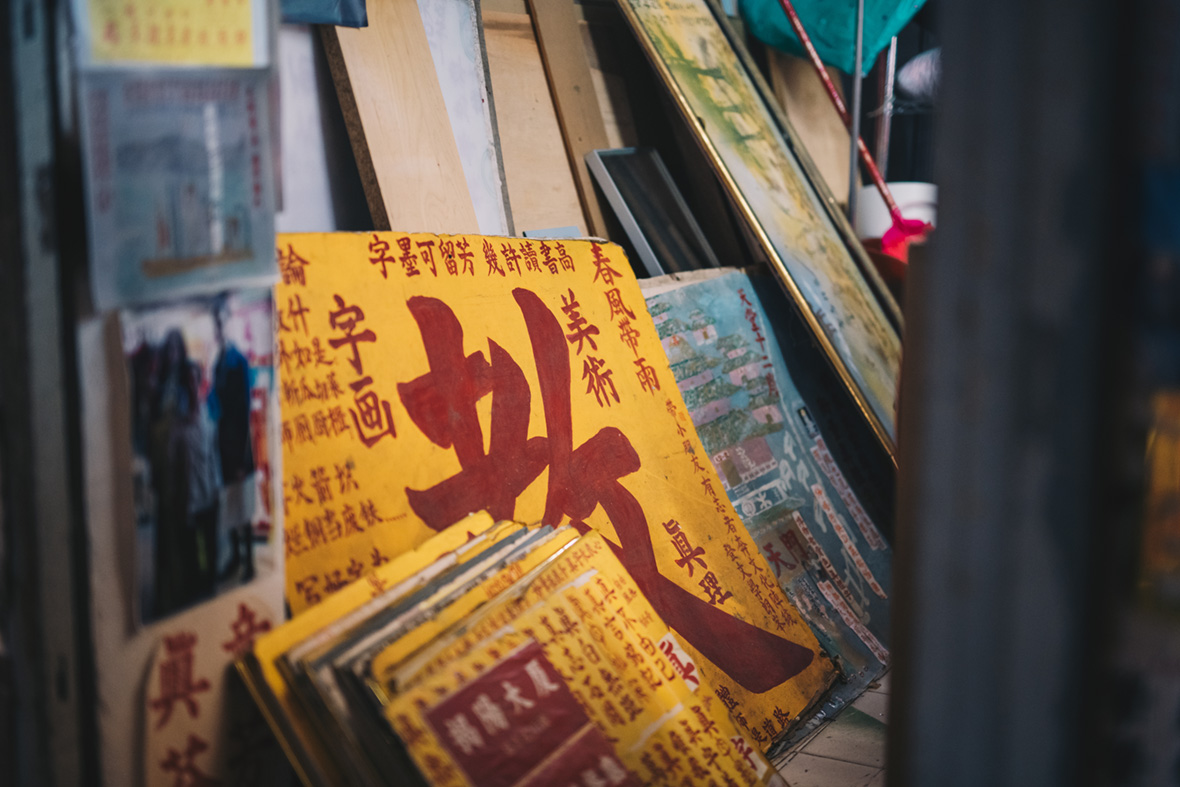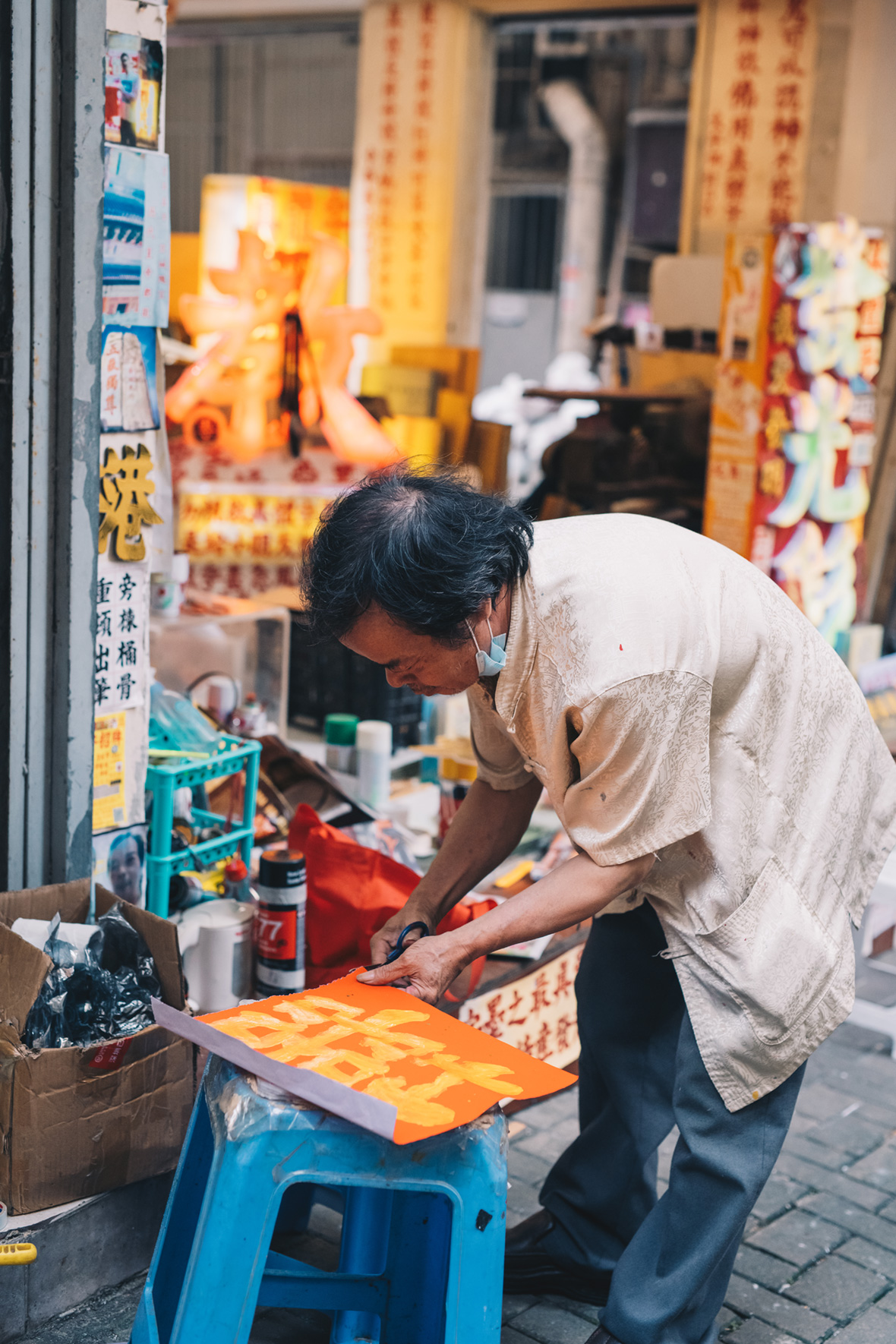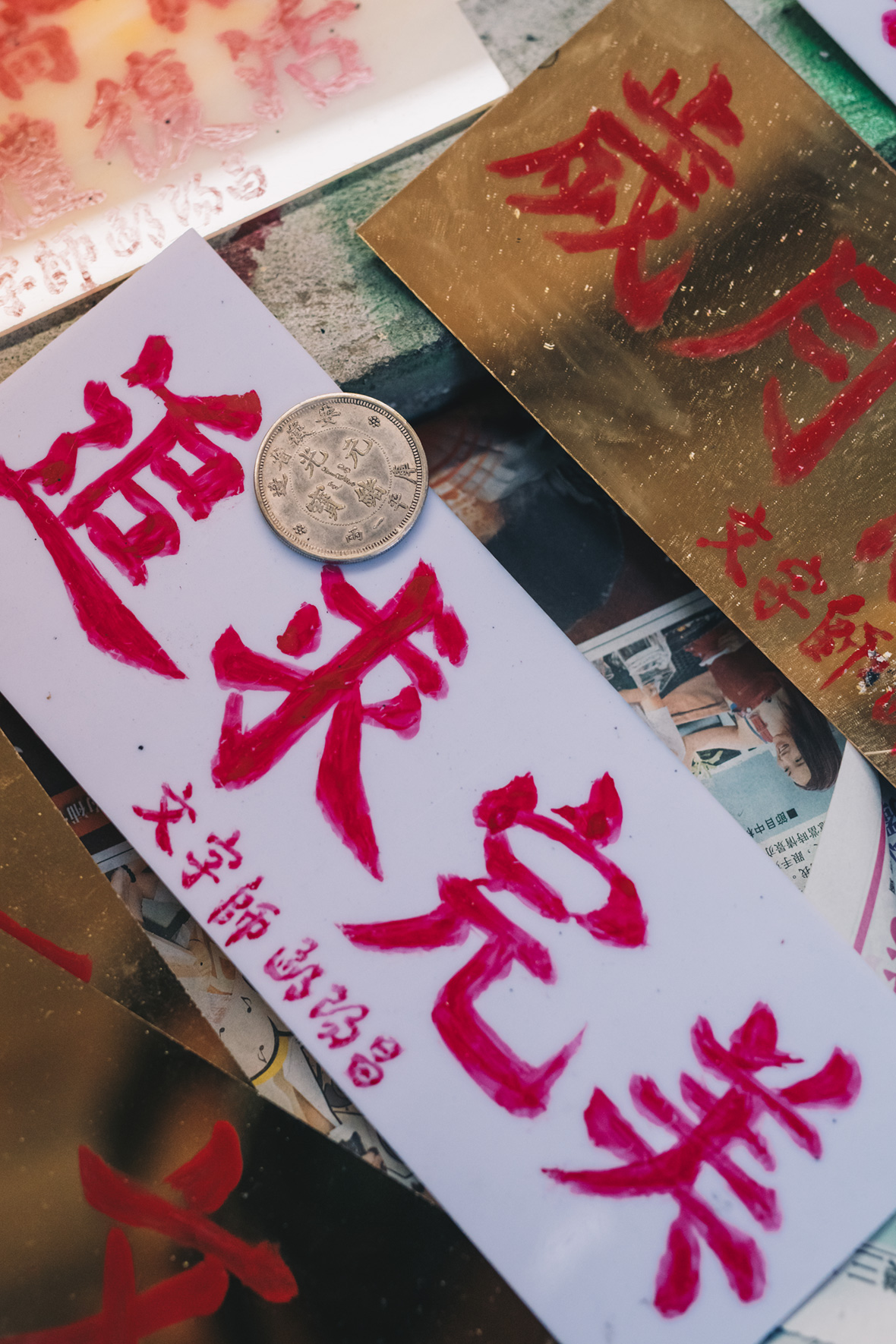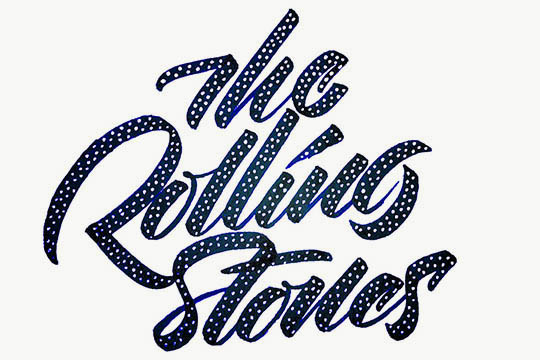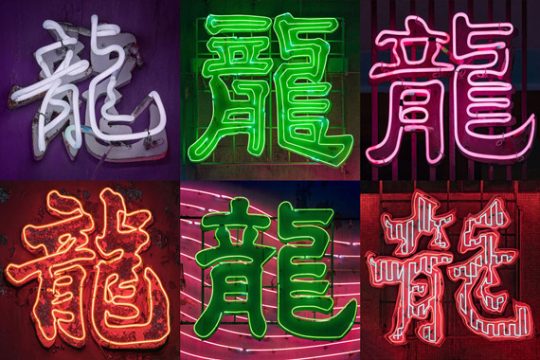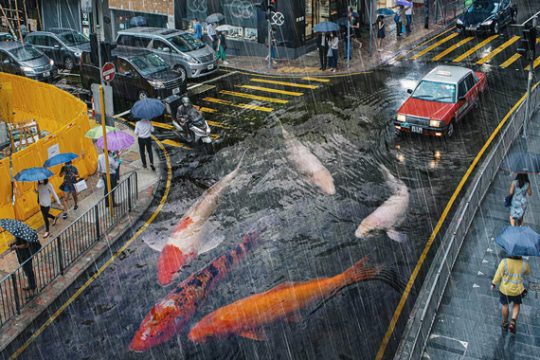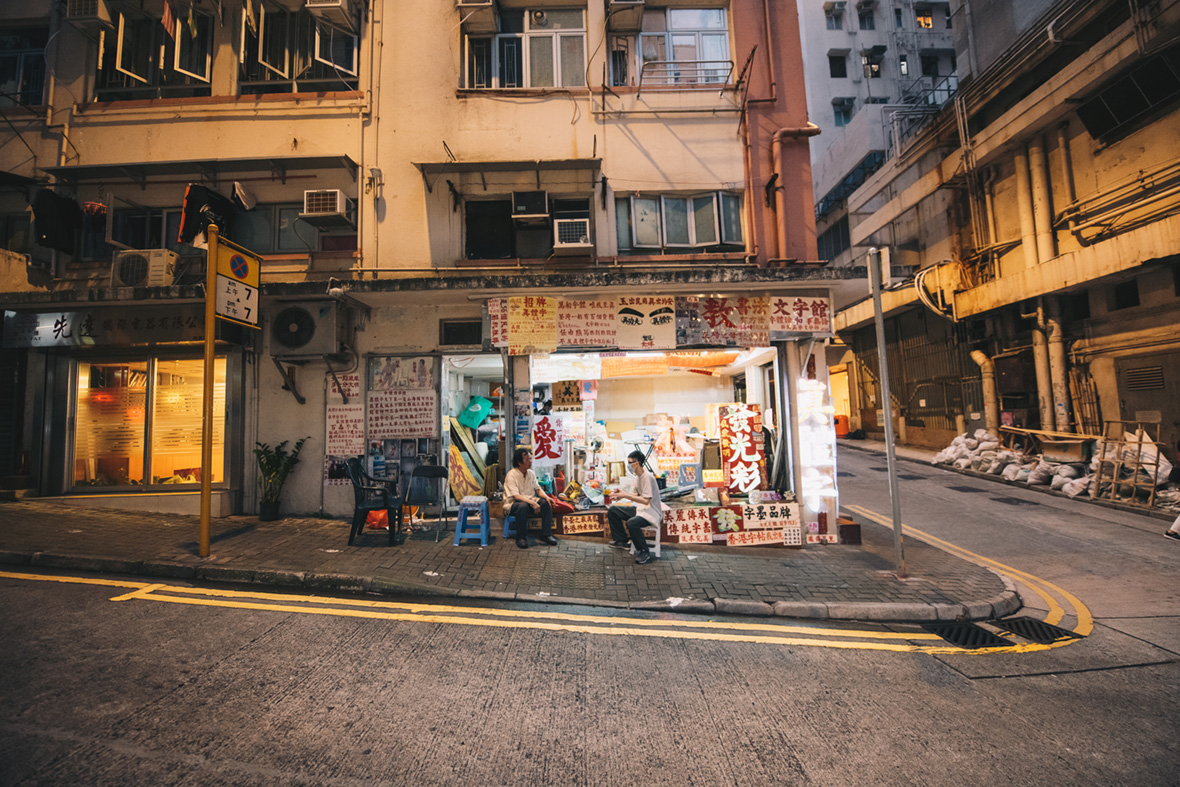
On an unassuming street corner in North Point, a piece of Hong Kong history glows brightly in gold, red, and white. This is Au Yeung Cheong’s calligraphy shop, where his work covers every available surface, even the ceiling. Inside, it almost feels like a 360-degree virtual interactive gallery of ’90s-era Hong Kong typography, with signage handwritten in Chinese characters crammed into every available inch of the shop. And at 63 years old, Au’s story definitely includes a lot of history.
欧阳昌的招牌制作店位于香港北角一个不起眼的街道拐角处,金色、红色和白色的文字招牌讲述着香港的一段辉煌历史。店铺的四面墙壁以及天花板,密密麻麻摆满了欧阳昌的作品。一踏入店内,就仿佛进入一个全方位无死角的虚拟互动画廊,每一个角落都摆放着手写的中文招牌,充满 90 年代的香港风情。在现年 63 岁的欧阳的人生故事中,自然也见证了不少的历史。
He started learning calligraphy as a kid with some encouragement from his mom while living in the rural countryside of Shunde, Guandong. Reading calligraphy books his dad bought, he stayed up late teaching himself, working under candlelight since electricity wasn’t yet readily available there. “It felt like a remote island at the time,” he laughs. “It’s all the more rewarding now because I overcame the hardships.”
在母亲的鼓励下,他从小就开始学习书法。小时候,他和家人生活在广东顺德农村,由于没有电力供应,他常常到深夜还点着蜡烛,翻阅父亲买的书法书籍,自学书法。“那里好像一个离岛一样所以迟迟都不会有电的。”他笑着说道,“梅花香自苦寒来,真体字出自点火水灯钻研。”

In 1983, Au opened the King Wah Signboard shop in Hong Kong, tucked inside the historic State Theatre. His shop was set up next to an elevator that led to the upper floors, so there was a lot of foot traffic. But after a huge fire in 1995, and the theater’s shuttering in 1997, businesses slowly began disappearing until he was nearly alone inside the building’s darkened marketplace. He only recently relocated down the street after developers offered him some financial assistance. But there are plans to preserve and restore the building, and Au hopes to return to his original State Theatre location one day.
1983 年,欧阳昌的“京华招牌”在香港开张,地址就在历史悠久的皇都戏院内。他的店铺旁边就是通往戏院的扶手电梯,因此人流量很大。然而 1995 年的一场大火导致戏院在 1997 年关闭,周围的店铺也日渐式微,最后,欧阳昌成为了这幢冷清的商业大楼里唯一仍在开张的店铺。直到最近获得开发商提供的一些资金补助之后,他才搬到街上另一个位置。这幢大楼之后很可能会被保留和重新修建,因此,欧阳昌希望终有一天能重回皇都戏院。
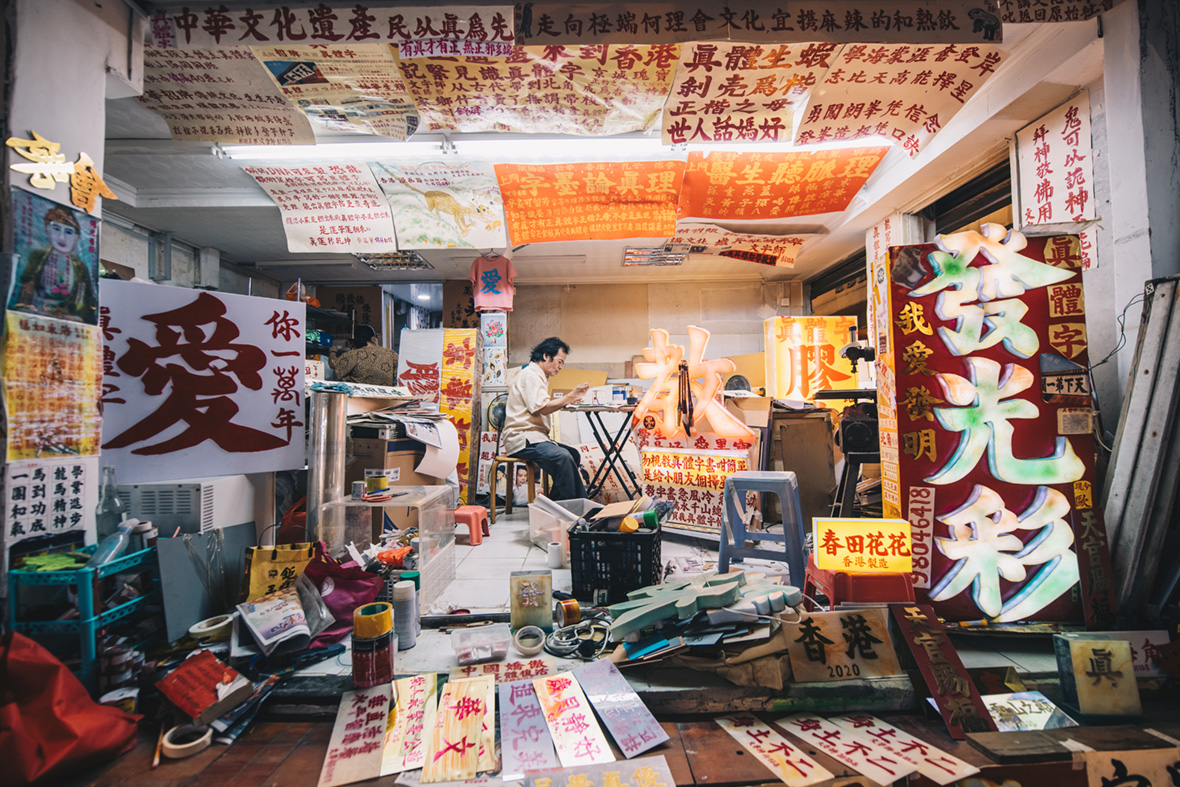
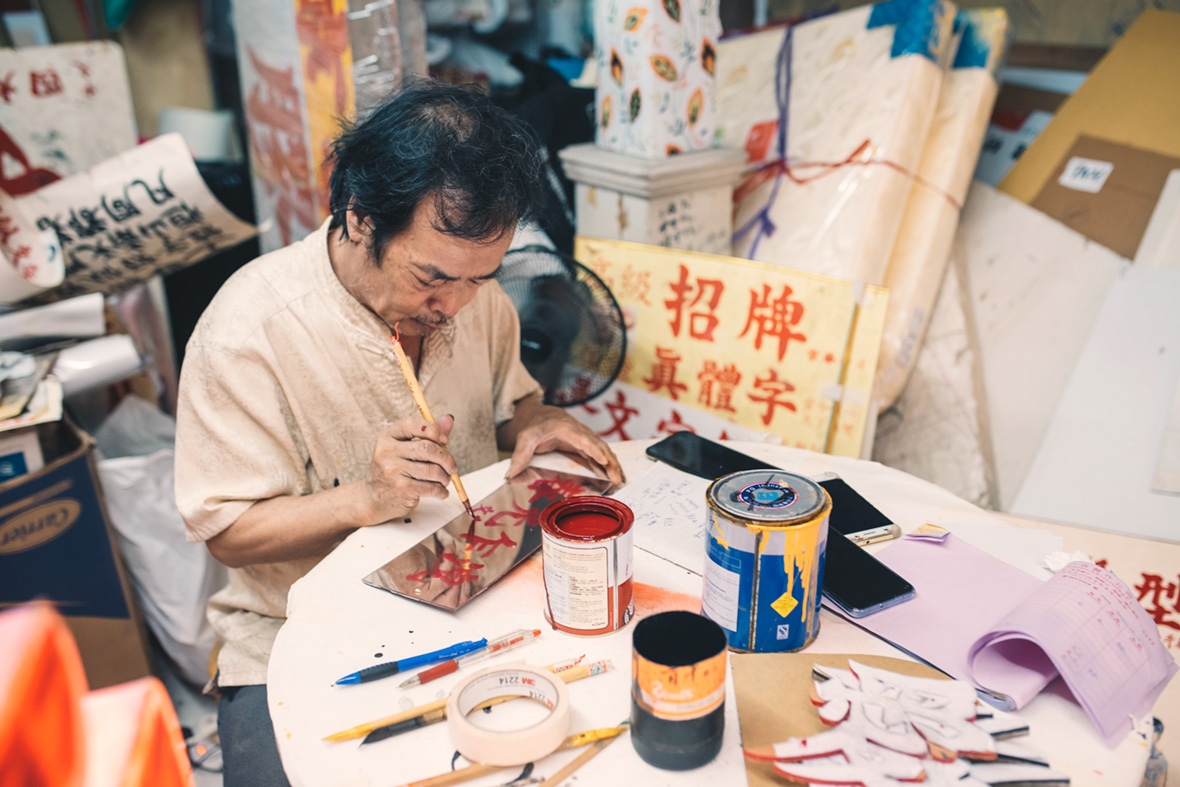
Over the years, Au has remained insistent with sticking to a style of Chinese calligraphy, which he claims to be “real script,” describing it as the most authentic version of regular script, one that’s informed by ancient calligraphy from all around the region. He believes an important era of calligraphy was lost when the Old Summer Palace was burned down during the Qing Dynasty. “The original real scripts were burned,” he sighs.
多年以来,欧阳昌一直坚持创作名为“真体字”的书法字体,在他看来,这种字体是最正宗的正楷,深受周边地区的古代书法影响。他认为,清末英法联军火烧圆明园,对真体字书法带来了摧毁性的影响:“那些很真的字已经在火烧圆明园的时候被烧掉了。”
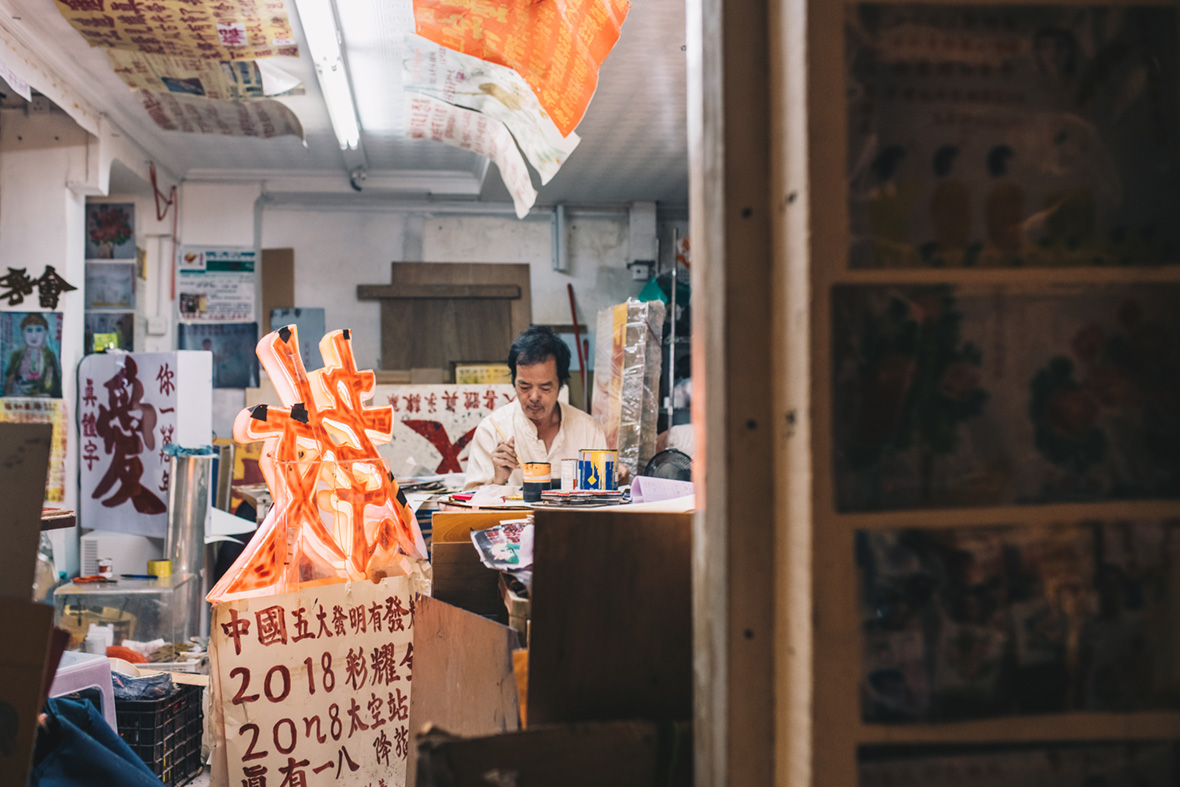
To reconcile that loss of history, Au turned to other ancient scriptures, studying how Chinese characters were written in Buddhist, Taoist, Guanyin, and Namaste texts. “After examining their brushstrokes, character structures, the way certain lines are slanted, and so on, I developed the real script I now work with.” Although it’s something he seemed to piece together on his own, older generations often recognize it. “When people in their 80s and 90s pass by my shop, they’d say, ‘Yes! I learned these characters when I was in school.'”
“Each stroke is perfectly symmetrical,” Au says of his script style. “Each character is compressed, and the strokes are interconnected. Every character occupies its own space, and they’re structurally dense—never loose or slumped over. In life, only when a person is ill do they slump over.” He says you need to understand every part of a script and that your knowledge grows like a multiplication table as you master each character.
为了弥补这段历史的缺失,欧阳昌潜心钻研其他古代经文,研究汉字在佛经、道经、观音经和南摩经的书写形式。“所有经书研究出来,原来落笔是这样的、结构是这样的,加起来才有我现在这样的真体字。”尽管这更像是他自己所拼凑而成的字体,但上了年纪的人都能看得懂这些字。“有一些八九十岁的老人认得到我的字,他说‘是了,我读卜卜斋(当时的私塾)的时候就是这些字’。”
谈到真字体的风格时,欧阳昌说:“它是端端正正的,四平八稳的,它每下一笔都是指着前上角下笔。字是不分散的,笔锋是连着的。一个字只有一个,称为结构紧密。它不会垂头丧气、烂头烂尾、四分五裂。一个人病了或者是牙痛,这才会垂头丧气的。”他认为在练习书法时,你需要了解字体的每一个笔画,这样,每掌握一个字,你的书法水平都能获得极大的提升。
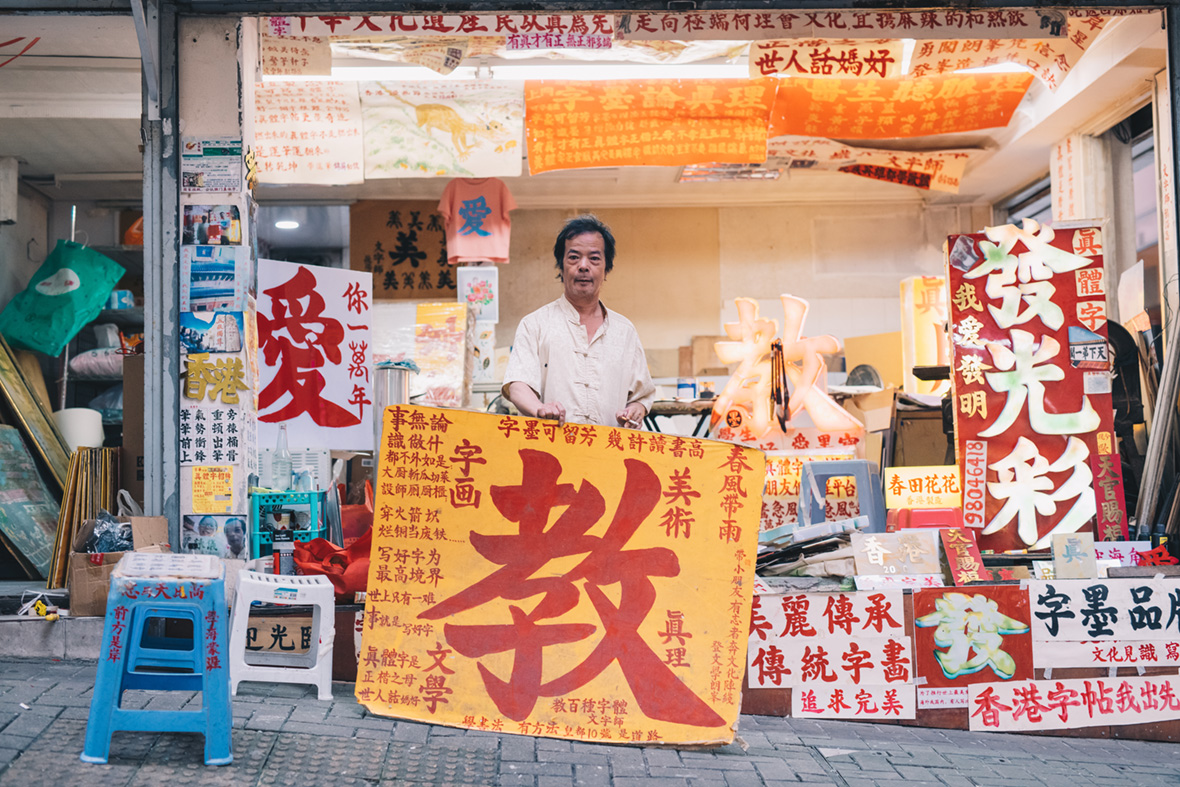
For all his musings about where history got things wrong, Au believes we’re in the middle of losing tradition once again, as people stop writing by hand. “Scripts have lost some of their qualities through printing. I hope to maintain them by doing it by hand.” To that end, he offers affordable lessons out of his shop, but he’s yet to have a student interested in sticking around, let alone master his style of calligraphy. He says it’s especially difficult to host apprentices considering the size of his small, cluttered shop. “I hope anthropology becomes more important that there’s more teaching in proper spaces where people can really learn,” he says. “If not, real script might disappear again.”
在反思历史问题之余,欧阳昌也认为,现代人越来越少写字,书法传统正再次处于消失的命运。“现在真体印出来变成了楷体一样,不是很真了,没有我的这么真。”为此,他除了开招牌制作店,还提供便宜的教学课程,但至今他还没有遇到愿意坚持下来的学生,更不用说掌握他的书法风格了。他说,自己的店铺空间狭小,杂乱无章,也不方便招收学徒。他说:“希望以后有关部门可以提供一个地方,有一些好的环境,才有更多的人学。”他不无惋惜地说道,“如果再没有人学,这些真体字会第二次或者是第三次失传的。”

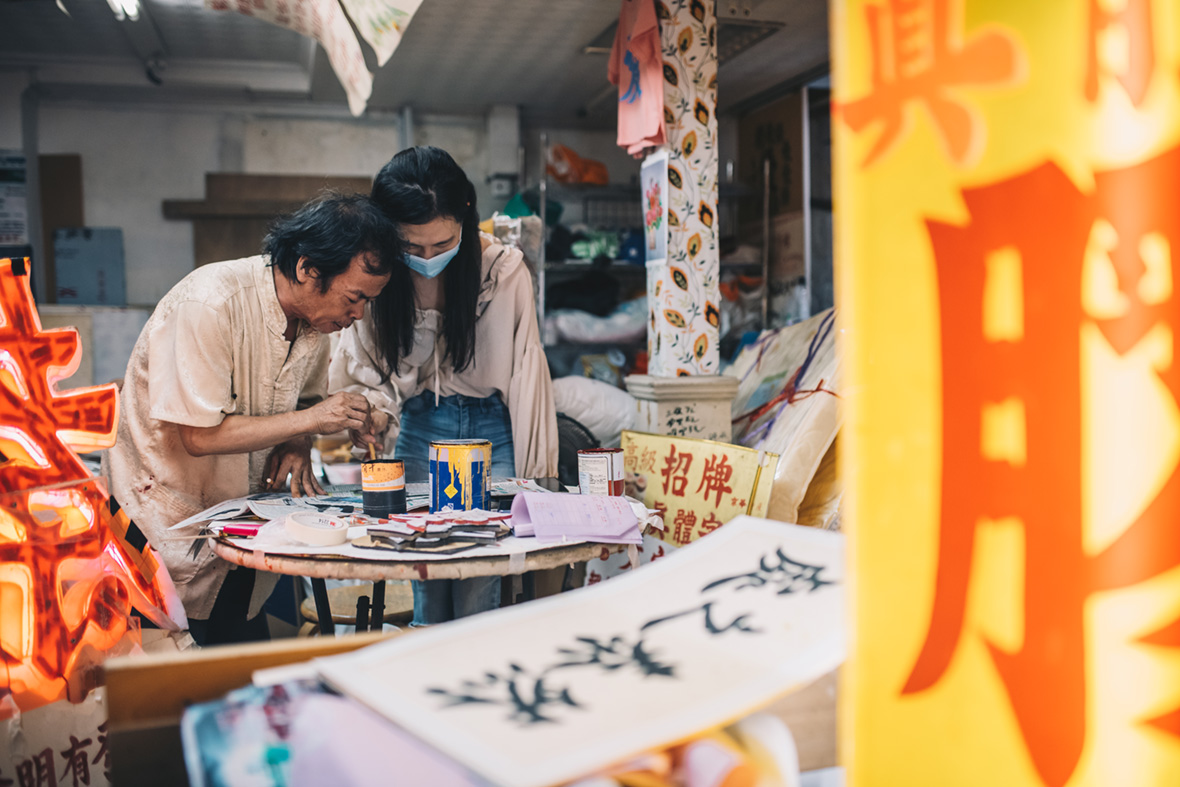
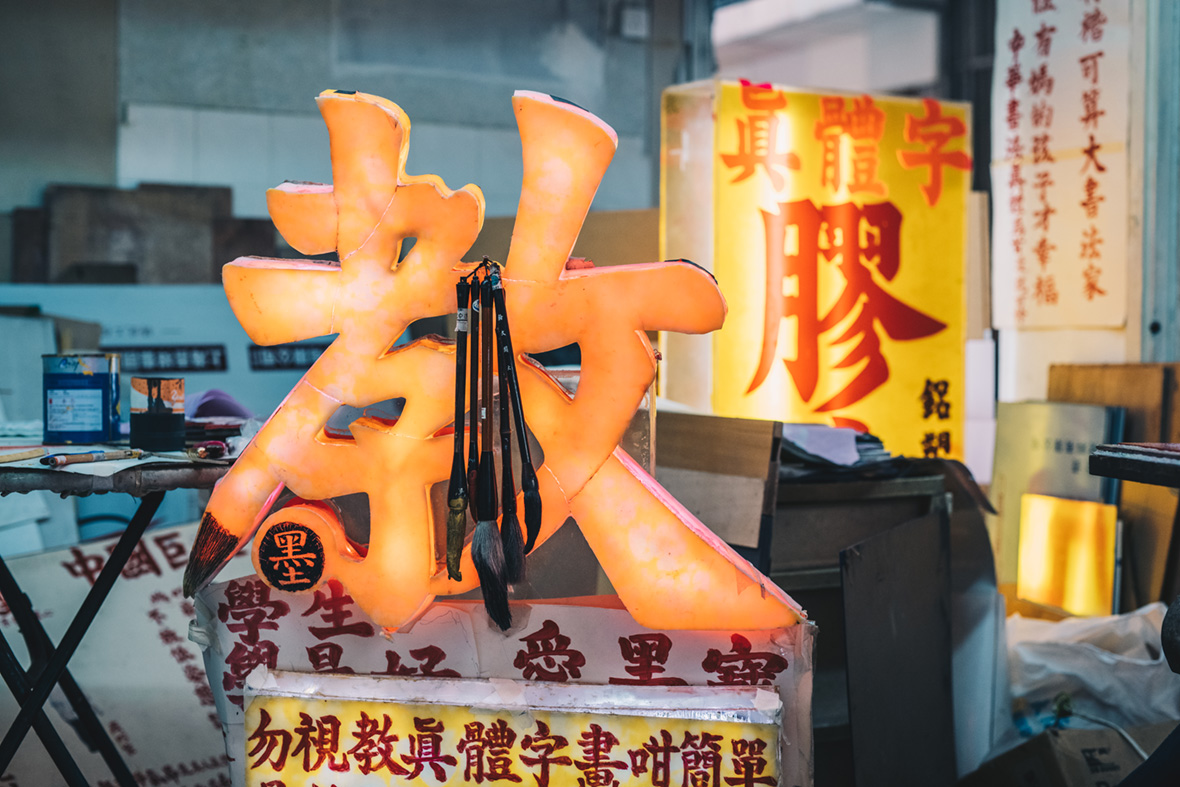
At his peak in the ‘90s, he employed over 20 staff members and his work could be found all over the city, but now he works alone in his small shop. He once made a lightbox sign that rivaled the Rolex sign in Causeway Bay. Au says that it’s mostly collectors who frequent his store these days. “In the past my clients only needed signage, it was exclusively for businesses and such,” he says. “But now, a lot of people want to collect my work, especially the younger generation.”
Because of media attention and coverage from local universities, students often come to his shop to purchase signage, lightboxes, and smaller trinkets as decorations. But there are still some commercial clients interested in his work. Earlier this year he created an installation sign for a Fashion Farm Foundation event, one of his favorite pieces to date. It’s even still hung in his store now. “Today, people are becoming more appreciative of the beauty in handwritten script. They realize it’s more elegant than digitized fonts.”
在上世纪 90 年代的巅峰时期,他曾雇用 20 多名员工,他的作品遍布这座城市,但现在,他独自一人在这间小店里工作。他所制作的一个灯箱招牌曾与铜锣湾劳力士店的招牌争光夺彩,而现在,光顾他的人大多都是收藏家。“过去我的顾客是只需要招牌,大部分是专供商业的。”他说道,“现在是有一点不同,有一些年轻人就帮衬我写的宣纸,把真体字用来收藏。”
在媒体和当地大学的报道和关注下,有越来越多学生到他的店里购买招牌、灯箱和一些精致的装饰品;与此同时,他的招牌也吸引了一些公司客户的兴趣。今年早些时候,他就为 Fashion Farm Foundation 活动创作了一个招牌艺术装置,这也是他迄今为止最喜欢的作品之一,现在还挂在他的店里,“现在,多了一些大学生、中学生,因为他们知道了我的字比电脑字应该是靓一点的。”
Like our stories? Follow us on Facebook and Instagram.
Instagram: @au.yeung.master
Contributor: Mike Steyels
Photographer: Tang Kam Hong Kenneth
Chinese Translation: Olivia Li


